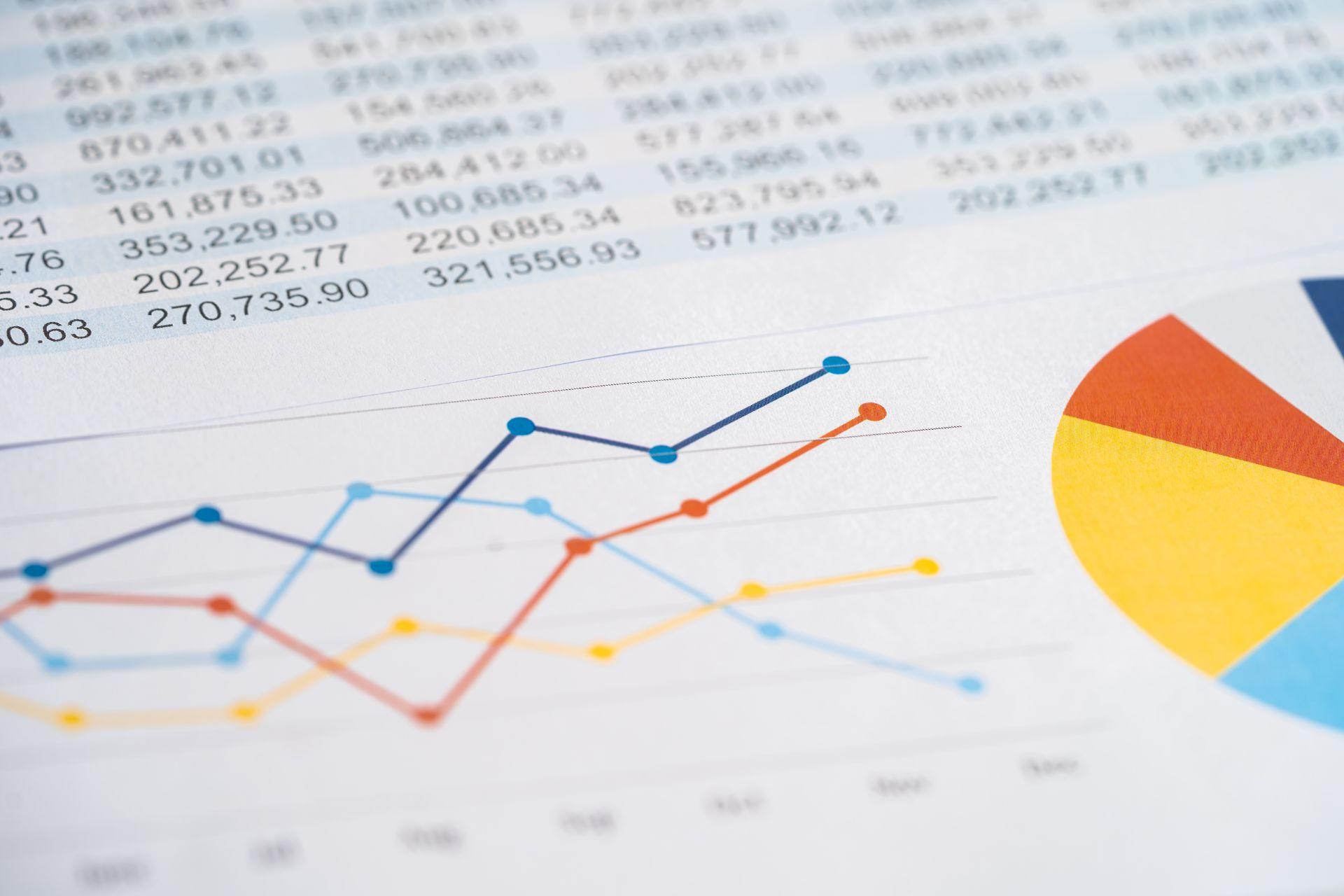Taking control of personal finances is by no means an easy task, but it is simple. Excel is the perfect tool to help you get a handle on finances and accounting for your household or small business! It’s more cost-effective than some other budgeting options and gives you more control over how to set up your documents. With its powerful formulas and user-friendly interface, Excel offers a fantastic platform for creating and managing personal budget spreadsheets.
Here, we will learn more about budgeting and accounting using Excel financial formulas so you can start keeping track of your money efficiently and effectively!

Why is Excel Good for Making a Budget?
Excel stands out as a powerful tool for creating and managing budgets. Its versatility and user-friendly interface make it an ideal choice for individuals and businesses alike. With unlimited ways to organize, format, and formulate, you can truly make your Excel budget into whatever you need it to be to suit your personal needs.
Flexibility and Customization
One of the key reasons why Excel is favored for budgeting is its flexibility. You can easily modify and tweak your budget spreadsheet to meet specific needs, whether it's a personal budget to track expenses or a comprehensive business budget to track cash flow and plan for revenue and expenses over time. Excel's grid structure allows you to create a layout that works for you, complete with custom fonts and colors, so you can easily decipher the data.
Calculation Accuracy
Excel's built-in mathematical functions and formulas ensure accurate calculations, reducing the likelihood of errors in budgeting. You can choose to use a pre-made template populated with the necessary formulas, or you can build your own budget from scratch and learn how to use Excel formulas at the same time.
The software handles complex calculations effortlessly, enabling users to perform tasks such as forecasting, variance analysis, and scenario planning. With Excel, budget creators can focus on strategic decision-making rather than getting bogged down by manual calculations.
Cost of Use
Excel is very affordable, especially compared to more automated budgeting apps and software. You can get a free online version of Excel at Microsoft.com. While the online version isn’t the exact same as the desktop version, it’s a very close match and you can make a perfectly functioning budget and more!

Why Should You Learn How Budgets in Excel Work?
Learning how to make and maintain budgets in Excel does more than just help you keep track of finances. Creating any kind of document in Excel always teaches you something and helps refine your spreadsheet skills.
Regardless of your role – be it a business professional, entrepreneur, or individual managing personal finances – mastering Excel's budgeting capabilities can significantly enhance your financial planning and decision-making abilities.
Pre-programmed functions to learn in Excel - expertise is important!
Career Advancement
For professionals in admin, finance, accounting, or business management, proficiency in Excel budgeting is a highly sought-after skill. Employers value individuals who can efficiently navigate and leverage Excel for financial analysis and planning. Acquiring expertise in Excel budgeting can open doors to career advancement and increased responsibilities (and salaries) within an organization.
Strategic Decision-Making
Understanding how budgets in Excel work allows you to make informed and strategic decisions. By creating detailed budgets, you’ll have up-to-date and reliable insights into your financial standing, identify areas for improvement, and develop strategies for achieving financial goals. Excel's analytical tools also enable users to perform what-if analyses, helping you evaluate the impact of different scenarios on your budgets.
Personal Financial Management
For managing personal finances, Excel provides a powerful tool for creating and maintaining budgets. Learning to use Excel for budgeting allows you to track income, expenses, savings, and investments in a systematic and organized manner. You can learn new methods for using Excel to suit your individual needs as well. This, in turn, fosters better financial discipline and can help you achieve your financial objectives.


How to Make a Budget Spreadsheet in Excel
Excel has tons of budget templates that you can easily select and use right away with your own budgetary numbers. You simply need to read any notes or instructions on the budget template and enter your information accordingly. Make sure not to change any of the pre-made formulas, or you risk breaking the entire sheet and rendering it ineffective!
If you want to learn more about Excel, the best way is to build your own sheets for a real-world application. And what better way to learn than to make an Excel expenses template for yourself?
You can try making a simple monthly budget template from scratch, which is what we will talk about here. Read on to find out just one of the many ways how to make a budget spreadsheet in Excel.
Step 1: Label Your Income Section
Let’s say you’re making a zero-based budget planner in this Excel document.
We will start by making some changes to formatting so the final result is easier to understand at a glance.
- Merge and center cells A1 to G2. In the merged section, write the name of the month you’re tracking expenses for.
- Merge and center cells A3 to A10. In the merged section, write “Income” as a side-heading.
- Merge and center cells B3 and C3. Use the AutoFill feature in Excel to automatically merge and center the cells below by clicking and dragging the lower right corner of cell C3 down to cell C10. Now, each of these rows should have a set of merged cells, too.
- In B3, write “Source” as in “source of income.”
- In cells A3 to A10, you can write the sources of income you currently get paid from. For example, “Salary,” “Side-Gig 1,” “Dividends,” “Etsy Sales,” etc.
- In D3, write “Date.” This is where you’ll track when you receive income. You can omit this column if it’s not important to you.
- In E3, write “Planned” or “Budgeted” or whatever verbiage you prefer. This is where you’ll write your expected income for each category listed in A3:A10.
- In F3, write “Actual.” This is where you’ll write what you actually received each month for each income category.
- In G3, write “Difference.” This will show you if you have a surplus or deficit in your planned and actual income.
- You might like to add a border around this entire “Income” section to make it easier to look at. You can even add colors as you’d like, and more! Customize your formatting the way you like it, but it’s best to keep things more simple and sleek.
Keep this process in mind, as we will repeat it (with different column headings) for the expenses section.
It’s a good habit to merge cells rather than change the height of a row or the width of a column when formatting a document. This way, you can be sure to have smaller units to work with when needed instead of being stuck with an extra-large column in a section you want a regular-sized column
Step 2: Add Formulas and Functions to Your Income Section
Without formulas and functions, you’ll have to calculate everything by hand which defeats the purpose of using Excel in the first place. So, next you must add formulas to your income section so Excel will automatically tell you everything you want to know when you enter the variable information.
- In the B10 cell, you can write “Total,” so you can keep track of all the totals for the month on this row.
- Highlight E4:E9 (the blank cells in the “Planned” column) and then click AutoSum to have Excel automatically create a total value beneath the last highlighted cell.
- Repeat this AutoSum process in the “Actual” and “Difference” columns.
- To set up the “Difference” column, in cell G4, enter the formula “=F4-E4” which is the “Actual” amount minus the “Planned” amount.
- Use the AutoFill feature to copy this formula down to G9.
Great! Now your income section is ready to start keeping track of your money.
Step 3: Set Up Your Expenses Section
What good is a budget that doesn't track money out? Refer to Step 1 for merging cells and formatting the monthly expenses list section.
- In the area beneath the Income Section, recreate the basic outline as the Income Section: Merge cells A11:B20 and label the merged cell “Expenses.” Instead of “Source,” you can call column B “Category.” Create “Date,” “Planned,” “Actual,” and “Difference” columns.
- Recreate the “Total” row at the bottom of the section.
- Recreate the AutoSum formulae for columns E and F.
- In column G, you’ll use the formula “E4-F4” which is the “Planned” amount minus the “Actual” amount. This will tell you if you overspent with a negative number.
- In the “Categories” column, list the expenses you know you have, like rent, electricity, car payment, groceries, tax, etc. You can make these categories any way that works best for you! So, you could have a category called “Food,” or you could break that idea up into groceries, restaurants, cafes, snacks, etc. If there’s a specific thing you tend to spend too much on, you might like to make it a specific category so you can see exactly how much it’s impacting your finances.
Some people like to add each payment as a line item in their budget to be very detailed. Others simply add expenses to a running total. It’s up to you which method you want to use!

Step 4: Optional Savings Section
If you want to see your savings on your budget, you can add another section below expenses (or elsewhere in your spreadsheet) to keep track. This can be helpful so you can see your savings grow as you hit your budgeting goals each month!
Simply recreate either the Income or Expenses section with the labels “Savings,” “Account or Category,” “Planned,” and “Actual.” You don’t need to have a “Difference” section unless you have specific savings goals and want to keep track of whether you’re meeting them each month or not.
If you have a savings account that gives you returns, you can enter a formula in the "Planned" column that takes into account the interest rate that you receive from the bank.
Step 5: Keeping Track
Each time you receive income or make a payment for an expense, you’ll simply add that amount to the proper category.
Use a simple addition formula and keep adding your amount at the end.
For example, let’s say you previously received a paycheck in the category “Salary” for $450.56 and now you just got another for $475.03.
In F4 (the “Actual” cell for this category), you can use the formula =450.56+475.03 and hit enter/return for Excel to automatically calculate the total. Next time you receive a paycheck in this category, simply add it to the string with a '+' to keep track of your earnings. That’s it!
Use this same procedure for other Income and Expenses (and Savings) in all categories and you’ll be keeping track of your finances in an easy-to-do and easy-to-understand way!
And now you’ve got a functioning personal monthly budget planner you can start using today!
Helpful Financial Formulas for Budgets in Excel
As you get better at making more intricate spreadsheets, you might want to start employing more advanced accounting formulas in Excel for budgeting and financial information, like calculating tax rates, keeping track of investment and debt, long-term costs, capital, appreciating or depreciating assets, net worth, and revenue.
You can even start tracking business expenses, assets, inventory, profit, and more! However, unless you become an Excel guru, it is wise to invest in budgeting software before your business expands beyond your ability to keep track of the various complicated financial elements of running a business, like taxes, payroll, and equity.
Organizing your data in Excel is especially helpful if you want to start making charts and graphs with the information and show data like the growth in profits or savings, the forecasted revenue, depreciating assets, and more.
Here is an Excel functions list of useful financial functions for budgeting and even accounting.
[table “us_101067” not found /]Find even more helpful functions in our other useful articles!
Excel Courses for Mastering Templates, Formulas, and More
If you want more insight on how to make a personal budget in Excel, like best practices for budget categories, how to best calculate monthly expenses, how to handle monthly bills, and more, you can easily find qualified tutors to teach you any number of Excel skills here on Superprof!
Learn how to use Excel for budgeting, accounting, and all kinds of financial processes with an individualized course. Whether you need help understanding how to use functions, learning best practices, or building pivot tables and charts, there is a perfect tutor on Superprof who can walk you through these complex Excel concepts.
Excel is the perfect computer program to build simple or complex budgets; it can do any mathematical functions you need for any calculations you require!















